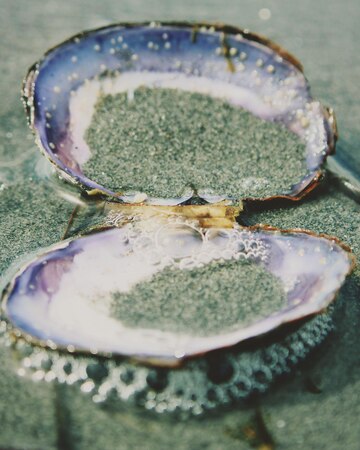The abalone shell is a fascinating natural creation admired for its vibrant colors and cultural significance. This shell, derived from the marine mollusk abalone, has captivated humans for centuries with its iridescent beauty and multifaceted uses.
What is an Abalone Shell?
An abalone shell is the outer protective covering of the abalone, a sea snail belonging to the Haliotidae family. These shells are characterized by their oval shape and unique, shimmering interior, which displays a spectrum of colors ranging from blues and greens to purples and pinks. The striking iridescence is due to microscopic calcium carbonate layers that reflect and refract light.
The outer surface of the shell is rough and often coated with a layer of algae or marine growth, while the inner surface, known as mother-of-pearl, is smooth and radiant.
How is an Abalone Shell Formed?
Abalone shells are formed through a biological process where the mollusk secretes calcium carbonate to build and strengthen its shell. The layers created during this process result in the nacre, or mother-of-pearl, which gives the shell its iridescent quality. The durability of the shell is a result of the microscopic tile-like structures that resist cracking and provide protection for the mollusk inside.
Uses of Abalone Shells
Jewelry and Decorative Arts
The stunning colors of the abalone shell make it a popular choice for jewelry and decorative arts. It is often cut into cabochons for rings, earrings, pendants, and inlaid in musical instruments or furniture for its eye-catching appearance.
Cultural and Spiritual Significance
Abalone shells hold profound spiritual and cultural importance in various traditions. Indigenous cultures, such as the Native American tribes, have used abalone shells in ceremonies and for crafting tools. The shell is also used in smudging rituals, where it serves as a vessel for burning sage during spiritual cleansing practices.
Culinary Uses
The mollusk itself, abalone, is a highly sought-after delicacy in various parts of the world, especially in Asian cuisines. The shells are often repurposed after consumption as decorative items.
Healing and Metaphysical Properties
Many believe that abalone shells possess healing properties, including stress relief and emotional balance. The shell’s oceanic origins are thought to bring calming energies, while its reflective nature symbolizes inner beauty and resilience.
Types and Regions of Abalone Shells
Abalone species are found in various regions globally, with each type presenting unique shell characteristics:
- Red Abalone (Haliotis rufescens): Found along the Pacific coast of North America, known for reddish hues.
- Paua Shell (Haliotis iris): Native to New Zealand, famous for vibrant blues and greens.
- Green Abalone (Haliotis fulgens): Located off the California coast, showcasing green and teal patterns.
Caring for Abalone Shells
To preserve the natural beauty of abalone shells, proper care is essential:
- Cleaning: Use mild soap and lukewarm water to clean the shell gently.
- Avoid Chemicals: Harsh chemicals can damage the delicate nacre.
- Storage: Store in a soft cloth to prevent scratches.
Conservation and Ethical Sourcing
Due to overharvesting and habitat destruction, many abalone species are now protected under conservation laws. When purchasing abalone shells or related products, it’s important to choose ethically sourced options to support sustainability efforts.
Conclusion
The abalone shell stands as a remarkable symbol of nature’s artistry, blending biological wonder with cultural significance. Whether admired for its dazzling beauty, worn as jewelry, or used in spiritual practices, the abalone shell continues to inspire and connect people to the ocean’s mysteries.
also read this Maraca Camera Brand: Full Details and Features Explained










